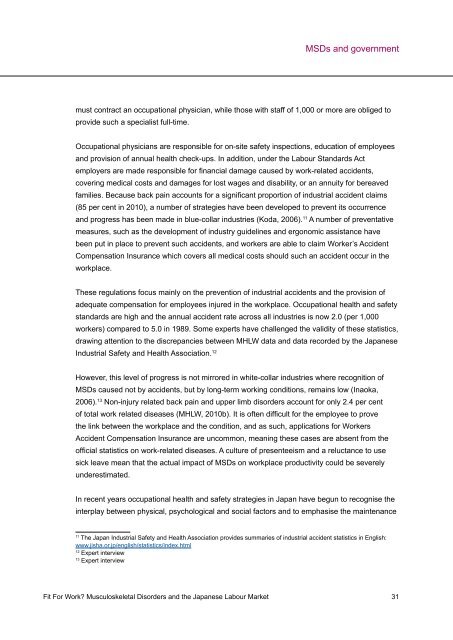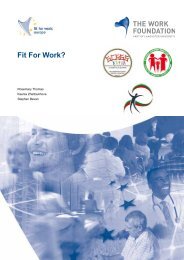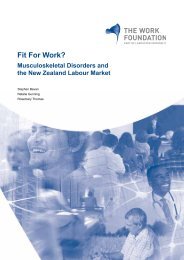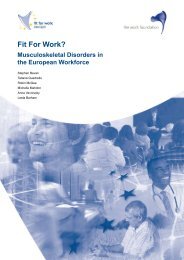English version - Fit for Work Europe
English version - Fit for Work Europe
English version - Fit for Work Europe
You also want an ePaper? Increase the reach of your titles
YUMPU automatically turns print PDFs into web optimized ePapers that Google loves.
MSDs and government<br />
must contract an occupational physician, while those with staff of 1,000 or more are obliged to<br />
provide such a specialist full-time.<br />
Occupational physicians are responsible <strong>for</strong> on-site safety inspections, education of employees<br />
and provision of annual health check-ups. In addition, under the Labour Standards Act<br />
employers are made responsible <strong>for</strong> financial damage caused by work-related accidents,<br />
covering medical costs and damages <strong>for</strong> lost wages and disability, or an annuity <strong>for</strong> bereaved<br />
families. Because back pain accounts <strong>for</strong> a significant proportion of industrial accident claims<br />
(85 per cent in 2010), a number of strategies have been developed to prevent its occurrence<br />
and progress has been made in blue-collar industries (Koda, 2006). 11 A number of preventative<br />
measures, such as the development of industry guidelines and ergonomic assistance have<br />
been put in place to prevent such accidents, and workers are able to claim <strong>Work</strong>er’s Accident<br />
Compensation Insurance which covers all medical costs should such an accident occur in the<br />
workplace.<br />
These regulations focus mainly on the prevention of industrial accidents and the provision of<br />
adequate compensation <strong>for</strong> employees injured in the workplace. Occupational health and safety<br />
standards are high and the annual accident rate across all industries is now 2.0 (per 1,000<br />
workers) compared to 5.0 in 1989. Some experts have challenged the validity of these statistics,<br />
drawing attention to the discrepancies between MHLW data and data recorded by the Japanese<br />
Industrial Safety and Health Association. 12<br />
However, this level of progress is not mirrored in white-collar industries where recognition of<br />
MSDs caused not by accidents, but by long-term working conditions, remains low (Inaoka,<br />
2006). 13 Non-injury related back pain and upper limb disorders account <strong>for</strong> only 2.4 per cent<br />
of total work related diseases (MHLW, 2010b). It is often difficult <strong>for</strong> the employee to prove<br />
the link between the workplace and the condition, and as such, applications <strong>for</strong> <strong>Work</strong>ers<br />
Accident Compensation Insurance are uncommon, meaning these cases are absent from the<br />
official statistics on work-related diseases. A culture of presenteeism and a reluctance to use<br />
sick leave mean that the actual impact of MSDs on workplace productivity could be severely<br />
underestimated.<br />
In recent years occupational health and safety strategies in Japan have begun to recognise the<br />
interplay between physical, psychological and social factors and to emphasise the maintenance<br />
11 The Japan Industrial Safety and Health Association provides summaries of industrial accident statistics in <strong>English</strong>:<br />
www.jisha.or.jp/english/statistics/index.html<br />
12 Expert interview<br />
13 Expert interview<br />
<strong>Fit</strong> For <strong>Work</strong>? Musculoskeletal Disorders and the Japanese Labour Market 31







